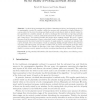13 search results - page 2 / 3 » Formally Bounding the Side-Channel Leakage in Unknown-Messag... |
CRYPTO
2010
Springer
13 years 2 months ago
2010
Springer
We present a general method to compile any cryptographic algorithm into one which resists side channel attacks of the only computation leaks information variety for an unbounded nu...
CRYPTO
2003
Springer
13 years 10 months ago
2003
Springer
Can you guarantee secrecy even if an adversary can eavesdrop on your brain? We consider the problem of protecting privacy in circuits, when faced with an adversary that can access ...
ET
2010
13 years 3 months ago
2010
In this work we investigate the problem of simultaneous privacy and integrity protection in cryptographic circuits. We consider a white-box scenario with a powerful, yet limited at...
EUROCRYPT
2009
Springer
14 years 5 months ago
2009
Springer
A weak pseudorandom function (wPRF) is a cryptographic primitive similar to ? but weaker than ? a pseudorandom function: for wPRFs one only requires that the output is pseudorandom...
CCS
2007
ACM
13 years 11 months ago
2007
ACM
Distance bounding protocols have been proposed as means of detecting relay attacks, also known as mafia fraud. In this paper we present the first symmetric key based distance bou...

